Station:
Dreis

Rechter Seitenalter mit einer Figur des Heilgen Josephs, darüber ein Bild mit der Heiligen Magdalena
The chronicle of the once “free imperial village” of Dreis, published in 1985 on the occasion of the first documentary mention in 785, reports that Abbot Hormann of Echternach had the church of St. Martin (49° 56′ 31˝N / 6° 48′ 49˝ E) built on the northern outskirts of Dreis in 1755/56. The abbey, which was independent of the empire, exercised rule in Dreis on behalf of the empire. The parish belonged to the Archdiocese of Trier. The church features a tower – not only for bells, but as a signpost to heaven. The tower rises like a sign towards the west, where the sun sets. During the last renovation, attention was paid to restoring the church to its original baroque state. For this reason, there are two pedestals with no figures on them in the chancel. They used to be occupied by two large angels in neo-Gothic style that did not fit into the baroque ensemble. They were removed and repositioned in the orchard of the rectory. During this renovation, the people of Dreis were concerned about the stability of the building, which is why the vault was secured with a concrete bolt. A scaffold was built from the vineyard, which was situated higher up, via which horses then transported the heavy loads to the church roof. The animals were blindfolded to prevent them from getting scared at the high altitudes. The women of that time took care of new lighting. They kept raising money through donations and campaigns until they had financed the Italian chandeliers in the nave.
The parish office of St. Martin Dreis quotes “its church” as follows:
“Our life is like a path; the church is God’s people, on pilgrimage. The destination is God himself in his ‘holy city’, in heavenly ‘Jerusalem’. Our church strives to be an image of the auspicious home with God. It opens in the small antechamber, the so-called paradise, the vestibule of heaven. The outside of the doors of the portal depict the cutting of St. Martin’s cloak.
The soaring architecture, the bright windows, the light-flooded space, the weightlessness of the vault point to the ever-flourishing meadows of paradise, to the new heaven and the new earth. Once there, you have no more need for a stone building, nor sun or moon. God himself is there, and he is the never-fading light.”
These spiritual and visionary thoughts are not only used to describe the church – they also reflect the landscape on the Eifel Pilgrimage Cycle Route.

Das Barock-Schloss Dreis ist heute der Stammsitz des Georg Graf von Walderdorff.
Another attraction in Dreis is the St. Martin acid spring, which is mentioned in documents as early as the 16th and 17th centuries. A modern, open drinking fountain was created in front of Brückenstraße 10 in 1997. The spring water is referred to as sodium-calcium-hydrogen-carbonate acidulous water and is a healing water, as its therapeutic value has been proven. A drinking cure helps with stomach complaints and chronic, benign infections of the urinary tract (no guarantee!).

Hochalter aus dem Barock mit der St. Martin-Szene und Maria darüber
Quelle:
- Pfarrkirche St. Martin (S. 670ff) in Hesse, G. & Wiseniewski, A. (1990): Wittlich-Land – Geschichte einer Verbandsgemeinde zwischen Vulkaneifel und Mosel, VG-Chronik.
Spring – life and healing
“Of course everyone that drinks of this water will become thirsty again at some point. But those who drink of the water I give the people will no longer know the idea of thirst. The water I give the people will turn into a spring inside of you, a spring that will gush without end, beyond your life in this world!”
Text: Volxbibel, Johannes 4, 13ff / Copyright: Martin Dreyer · Im Lichtenhain 20, 10317 Berlin · martin@volxbibel.de
E-bike charging station
At this station you will find an e-bike charging station! It is located at Talstraße 12e in Dreis.
